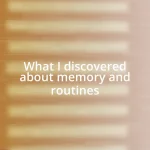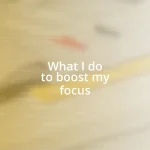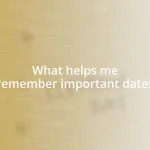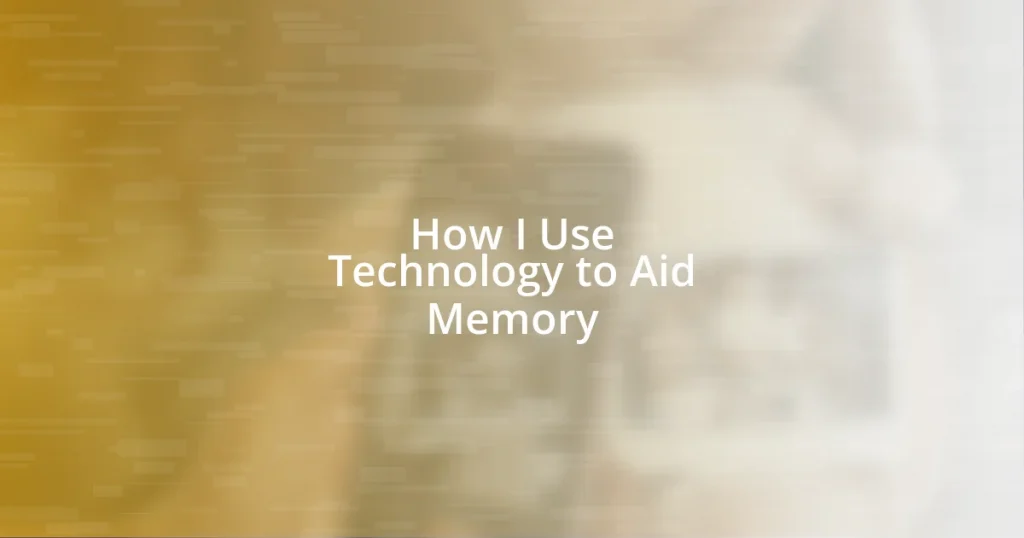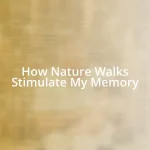Key takeaways:
- Technology enhances memory through tools like apps for organization, reminders, and interactive learning methods, making studying and task management more efficient and enjoyable.
- Wearable technology, such as smartwatches and fitness trackers, aid memory retention and cognitive function by providing reminders and encouraging physical activity which is linked to improved mental performance.
- Effective memory techniques include storytelling, visualization, and memory palaces, which can make recalling information more engaging and successful by creating vivid connections to the material learned.

Understanding Memory and Technology
Memory is a fascinating mental process, and incorporating technology into it feels like having an extra brain. I can still vividly remember the first time I used an app to organize my notes for a big project. It was a revelation—a digital way to categorize my thoughts actually made the overwhelming information feel manageable.
Have you ever felt lost while studying or preparing for something important? I have. I often found myself staring at a wall of text, feeling like the more I read, the less I understood. Technology changed that for me. By using reminders and flashcard apps, I transformed my approach to learning; instead of dreading the task, I could engage with the content interactively and with excitement.
It’s interesting how devices designed to connect us can also enhance our memory. When I set digital reminders for birthdays or significant deadlines, it not only helps me keep track of important dates but also fosters meaningful interactions. Each alert is like a small nudge, allowing me to cultivate relationships while keeping my memory sharp. Isn’t it funny how a simple alarm can evoke feelings of joy when it reminds us to connect with loved ones?
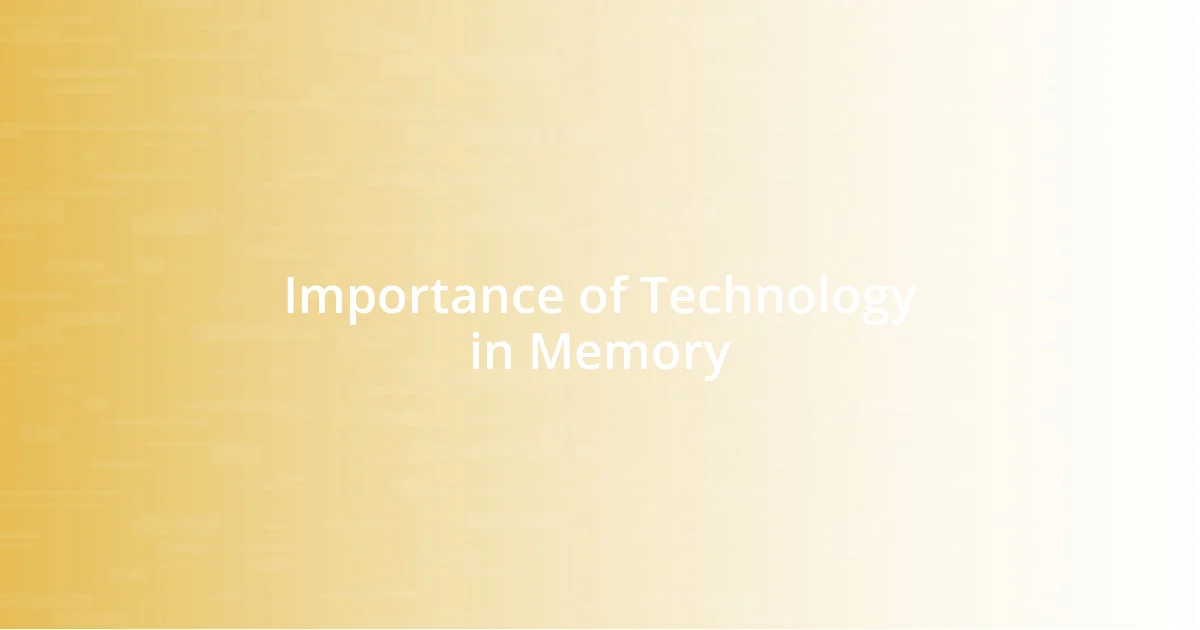
Importance of Technology in Memory
In today’s fast-paced world, technology plays a crucial role in strengthening our memory. When I first started using a note-taking app, it felt like I had a digital assistant by my side. The ability to tag and search information right when I needed it not only saved me time but also helped me better retain concepts by accessing them swiftly, ensuring I was constantly engaging with the material.
Moreover, studying has become more efficient for me with the myriad of tools available today. I remember grappling with revision for a particularly challenging exam—scattering notes everywhere. The introduction of visual aids and mind-mapping software completely transformed the process. Now, I can visually connect ideas, which reinforces comprehension and recalls for me in a way that traditional methods never could.
Interestingly, the use of technology extends beyond studying into daily reminders and organization. I’ve discovered that creating to-do lists on my phone not only helps me prioritize tasks but also enhances my mental agility. Every checkmark brings a sense of accomplishment. This emotional boost fuels my motivation, proving that technology isn’t just about data—it’s an ally in making our memories more potent and our lives more organized.
| Aspect | Traditional Methods | Technology Aids |
|---|---|---|
| Accessibility | Papers and Notebooks | Apps and Digital Platforms |
| Engagement | Passive Reading | Interactive Learning |
| Reminders | Manual Notes | Digital Alerts |

Types of Memory Aiding Tools
I’ve explored various memory aiding tools that dramatically enhance how I remember things. One standout for me is the use of apps like Evernote for organizing my notes. There was a time when I would lose track of ideas written in multiple notebooks, which was quite frustrating. Now, having everything in one accessible app has transformed my chaotic thoughts into a neatly organized framework, making recall seamless.
Memory Aiding Tools I Rely On:
– Flashcard Apps: They turn studying into a game, making review sessions enjoyable rather than tedious.
– Note-taking Software: This keeps my ideas centralized, allowing for easy access and better organization.
– Reminder Applications: I set reminders for everything, from medication to daily tasks, reducing my anxiety about forgetting important things.
– Mind Mapping Tools: They help me visually structure concepts, enhancing my understanding and retention.
– Calendar Apps: I adore having my schedule at my fingertips, which helps me manage time and commitments effectively.
These tools not only boost my productivity but also give me peace of mind, knowing that I have effective strategies to support my memory.
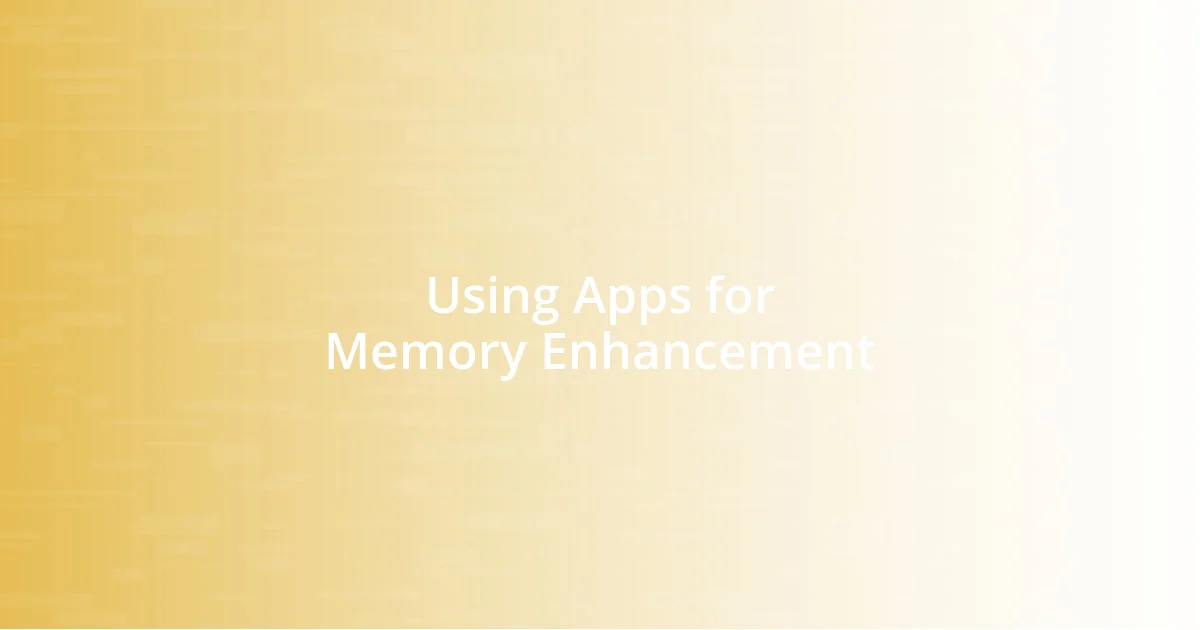
Using Apps for Memory Enhancement
Using apps to enhance memory has truly broadened my horizons. One of my favorites has to be Duolingo; it turned language learning into an enjoyable challenge. I remember fitting in short lessons during my daily commute. Not only did this make the most of my travel time, but it also helped me retain vocabulary and phrases by constantly interacting with the material in a fun way.
Then there’s Forest, an app that encourages focus by growing a virtual tree for every session I commit to studying without distractions. I find that this not only boosts my concentration but adds a visual commitment to my memory practice. Watching my virtual forest grow adds a sense of achievement that motivates me to stay on track. How often do we find ourselves distracted by notifications? With this app, I feel a stronger connection to my goals, reinforcing the memories created during focused study sessions.
Lastly, I often use Anki, a flashcard app that employs spaced repetition to help me memorize complex subjects. Initially, I was skeptical. Can a digital card really outmatch my trusty index cards? Yet, after using it, I realized that the personalized learning path it provides keeps me engaged and learning efficiently. It’s fascinating—you can literally watch your knowledge expand as the app adapts to your progress, making the whole experience feel like a collaborative journey of learning.

Employing Wearable Technology
Wearable technology has become an essential part of my routine for enhancing memory. For instance, I use a smartwatch that vibrates gently to remind me about important tasks and appointments. It’s a small nudge, but those little vibrations can instantly bring a thought to the forefront of my mind. Don’t you find it amazing how a simple notification can keep us on track?
Another experience I cherish is when I track my health using a fitness tracker. Keeping tabs on my physical activity correlates to improved cognitive function. I noticed a significant difference in my focus and memory retention on days when I’m active. It’s fascinating how engaging in physical movement can create a ripple effect, sharpening my mind as well. Have you ever wondered how much our body influences our mental capacity?
Lastly, my favorite feature of my wearable tech is the sleep tracker. By monitoring my sleep patterns, I can prioritize rest, which I’ve learned is crucial for memory consolidation. There was a time when I underestimated the power of sleep, often sacrificing it for work. Now, I truly value that its quality directly impacts how well I can recall information the next day. Isn’t it rewarding to see how interconnected these aspects of our lives can be?

Techniques for Effective Memory Practice
One memory technique that has worked wonders for me is incorporating storytelling into my learning process. Whenever I need to memorize a list or a set of complex concepts, I weave them into a narrative. This makes the information more vivid and relatable. I often find myself recalling those stories long after I’ve studied them. Isn’t it fascinating how our brains are wired to remember stories better than isolated facts?
Another effective method I utilize is the power of visualization. When I’m trying to remember a specific date or fact, I visualize it in a colorful, exaggerated way in my mind. I recently managed to remember a friend’s birthday by picturing their name written in giant, glowing letters on a cake. This vivid image stuck with me—it’s incredible how a bit of creativity can transform plain information into something memorable. What techniques do you use when you’re faced with similar challenges?
Lastly, I often participate in memory palaces. This technique involves associating the information I need to remember with specific locations in a familiar setting. I actually use my childhood home for this purpose. For instance, I’d place a new concept in the living room and another in the kitchen. Walking through the mental layout helps me retrieve those ideas later. This method transforms my memory practice into a fun scavenger hunt that engages my mind. Have you ever tried creating a mental map for your own memories?

Evaluating Technology’s Impact on Memory
Evaluating technology’s impact on memory reveals a nuanced landscape. I often find myself pondering how apps designed for reminders and task management have altered my daily routines. For instance, there was a time I relied solely on post-it notes, but now, digital platforms allow me to organize tasks efficiently. I wonder if others feel similarly liberated by these innovations.
In my experience, the blending of social media and memory can be a double-edged sword. While platforms like Facebook jog my memory by reminding me of past events and friendships, they also risk overwhelming me with information. Have you ever scrutinized how scrolling through memories can both evoke warmth and provoke distraction?
Moreover, I’ve come to realize the critical balance between offline and online interactions. While digital tools help me record thoughts, I cherish moments with friends where we share memories face-to-face. This realization hit me during a recent dinner with old friends, where discussing shared experiences felt deeply enriching compared to merely scrolling through digital photos. Isn’t it curious how our memory is enhanced not just by technology, but also by genuine human connection?



